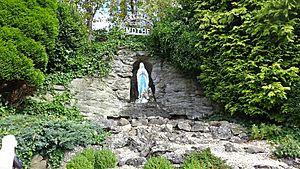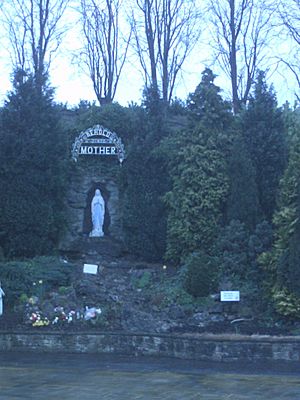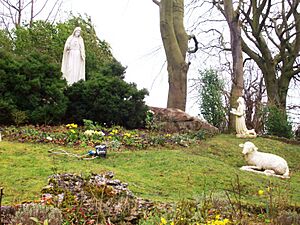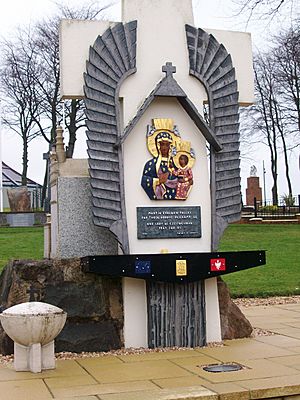Carfin Grotto facts for kids
The Carfin Lourdes Grotto is a special Catholic place in Scotland. It is dedicated to Our Lady of Lourdes, who is an important figure in the Catholic faith. This beautiful shrine was built in the early 1900s. People often call it the "Carfin Grotto."
The idea for the Grotto came from Canon Thomas N. Taylor, a local priest. He lived in the small mining village of Carfin, near Motherwell. After visiting a famous shrine in Lourdes, France, Canon Taylor wanted to create a similar place in Scotland. He wanted it to honor the Virgin Mary. Building this shrine became his life's goal. Since it opened in the 1920s, the Grotto has welcomed many thousands of visitors. It has grown with many Catholic symbols and buildings. Each year, from May to September, the Grotto holds special events. These include Sunday processions, prayers called rosaries, and outdoor church services.
Contents
Building the Carfin Grotto
Work on the Carfin Grotto began in the early 1920s. Local people built the shrine by hand. It was located across from the St. Francis Xavier's parish Church. Many of the builders were coal miners from Carfin and nearby villages. They were out of work during a big coal miners' strike in 1921. Canon Taylor wanted to keep these workers busy. He knew it would help their spirits during a tough time. He inspired them to work hard and with great dedication.
The project started with an empty field in 1920. The volunteers worked very hard, driven by their faith. The shrine was mostly finished within two years. It officially opened in 1922. The main part of the Grotto showed Mary appearing to Saint Bernadette. It had a brick garden and an altar for outdoor church services. Canon Taylor wrote a book about the shrine's first thirty years. He recorded that over 300 volunteers helped build the Grotto. He also noted that more than fifty thousand people visited in a single pilgrimage in 1924.
How the Shrine Grew
After opening in 1922, the Carfin Grotto quickly became a popular place for pilgrims. People came from all over Scotland and other parts of the world. Special services were held for Polish and Lithuanian communities living in Scotland. Hundreds of thousands of visitors, from different faiths, have come to Carfin.
The shrine grew from one field to many acres between 1922 and the 1960s. A Glass Chapel was added on a raised area above the main path. The Grotto grounds now have many life-size statues. These include statues of Jesus, Mary, and many saints. There is also a scene showing Jesus' life with Mary and Joseph in their home. This is shown in a cave. The Grotto also has a Reliquary, which holds special religious items. There is also a sunken garden. Many statues and other items were added to the main Lourdes Grotto area. Other parts include the Way of the Cross, many statues of saints, and a statue honoring Our Lady, Star of the Sea. This area even has miniature lakes.
On Sunday afternoons, from May to October, special Rosary processions take place. Thousands of visitors usually attend these. The local priest leads the rosary. This tradition was started by Canon Taylor and continued by his successor, Father George Mullen. The priest would stand on the Glass Chapel's edge. From there, he could see the Grotto and the procession along the paths. Each Sunday procession ended with a special blessing called Benediction in the upper Glass Chapel. Many local people remember kneeling on the gravel as children during this service.
Saint Thérèse of Lisieux
Canon Taylor also greatly admired Saint Thérèse of Lisieux, known as the "Little Flower." He learned about her life during his trips to France in the early 1900s. People there quickly began to honor her after she passed away in 1897. One reason for this was her autobiography, Story of A Soul, published after her death. Canon Taylor was very touched by her life story. He contacted the Carmelite convent where she lived in France. He became close with the Mother Superior and Saint Thérèse's three sisters, who were also nuns there. He wanted to help share her story.
Canon Taylor became an expert on Saint Thérèse. Starting in 1902, he wrote articles in Catholic newspapers. He wanted more people in the United Kingdom to know about her. Thanks to his efforts, her simple life of devotion to Jesus became well-known in Scotland, England, and Ireland. Canon Taylor believed Saint Thérèse would become a very important figure. He even spoke to the Vatican Committee that considered making her a saint. He was in Rome in 1925 when she was officially declared a Saint of the Church.
To show his devotion, Canon Taylor placed a statue of Saint Thérèse directly across from the statue of Our Lady of Lourdes. This statue was put up just weeks after she was declared "blessed" by Pope Pius XI in Rome on April 29, 1923. Canon Taylor attended this event. The decision to put her statue there caused some discussion. Some visitors felt that this "new" Saint's statue should not be so close to Mary's. Canon Taylor gathered these opinions and sent them to the Mother Superior of the Carmelite convent in France. The Mother Superior advised that the statue should stay. She predicted that the Carfin Lourdes Grotto would attract many pilgrims because of it.
Saint Thérèse of Lisieux is the second most important patron saint of the Grotto, after Our Lady. In August 2019, special relics of Bernadette of Lourdes were brought to Scotland. About 30,000 people came to visit these relics at the chapel and grotto. Students from Taylor High School, New Stevenston helped carry the relics.
Visitors from Far and Wide
By the time Canon Taylor passed away in 1963, the Carfin Lourdes Grotto was very well-known across the country. It attracted tens of thousands of pilgrims every year. Each May, children who had just received their First Communion visited from nearby churches. They came for a procession, with girls in white dresses and boys in school uniforms. Many Irish immigrants live in the area, and their groups visited the shrine annually. Lithuanian and Polish groups also made yearly pilgrimages to the shrine.
New Additions to the Grotto
After the 1988 Glasgow Garden Festival, a glass chapel used at the event was moved to Carfin Grotto. It was placed near the Our Lady, Star of the Sea area in the lower garden. This building, the Grotto's second Glass Chapel, was later dedicated in June 1989. It honored the victims of the Lockerbie Disaster. This was a terrible event where a plane crashed near the Scottish town of Lockerbie on December 21, 1988. Daily church services are now held in this glass chapel. It is named Our Lady, Maid of the Seas after the plane, Pan Am Flight 103.
More recently, the Reliquary opened within the Grotto grounds. It displays many religious items used over the years in various processions and celebrations.
A new Pilgrimage Centre opened in 1997. It had an exhibition about the history of different faiths and beliefs. It also showed various religious items. The center also had a café and a shop. In 2019, the local church leaders announced plans to close the pilgrimage center. This caused many people to sign a petition against the decision. The issue was discussed on BBC Radio 4's Sunday program on August 18, 2019. Since 2021, and as of August 2025, the website states that the pilgrimage center is currently closed. However, renovations are happening to reopen it.
See also
- Catholic Church in Scotland





